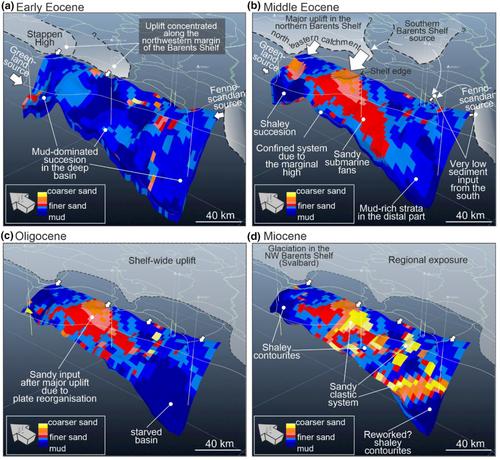当前位置:
X-MOL 学术
›
Basin Res.
›
论文详情
Our official English website, www.x-mol.net, welcomes your
feedback! (Note: you will need to create a separate account there.)
Unravelling controls on multi‐source‐to‐sink systems: A stratigraphic forward model of the early–middle Cenozoic of the SW Barents Sea
Basin Research ( IF 2.8 ) Pub Date : 2024-07-10 , DOI: 10.1111/bre.12883 Amando P. E. Lasabuda 1, 2, 3, 4 , Domenico Chiarella 2 , Tor O. Sømme 5 , Sten‐Andreas Grundvåg 1 , Anthony G. Doré 6 , Grandika Primadani 7 , Tom Arne Rydningen 1 , Jan Sverre Laberg 1 , Alfred Hanssen 1
Basin Research ( IF 2.8 ) Pub Date : 2024-07-10 , DOI: 10.1111/bre.12883 Amando P. E. Lasabuda 1, 2, 3, 4 , Domenico Chiarella 2 , Tor O. Sømme 5 , Sten‐Andreas Grundvåg 1 , Anthony G. Doré 6 , Grandika Primadani 7 , Tom Arne Rydningen 1 , Jan Sverre Laberg 1 , Alfred Hanssen 1
Affiliation

|
Source‐to‐sink dynamics are subjected to complex interactions between erosion, sediment transfer and deposition, particularly in an evolving tectonic and climatic setting. Here we use stratigraphic forward modelling (SFM) to predict the basin‐fill architecture of a multi‐source‐to‐sink system based on a state‐of‐the‐art numerical approach. The modelling processes consider key source‐to‐sink parameters such as water discharge, sediment load and grain size to simulate various sedimentary processes and transport mechanisms reflecting the dynamic interplay between erosion in the catchment area, subsidence, deposition and filling of the basin. The Cenozoic succession along the SW Barents Shelf margin provides a key area to examine controls on source‐to‐sink systems along a transform margin that developed during the opening of the North Atlantic when Greenland and Eurasian plates were separated (ca. 55 Ma onwards). Moreover, the gradual cooling which culminated in major glaciations in the northern hemisphere during the Quaternary (ca. 2.7 Ma), has affected the spatio‐temporal evolution of the sediment routing along the western Barents Shelf margin. This study aims to characterize the relative importance of different source areas within the source‐to‐sink framework through SFM. In the early Eocene, the SW Barents Shelf experienced a relatively equal sediment delivery from three principal source areas: (i) Greenland to the north, (ii) the Stappen High to the east, representing a local source terrain, and (iii) a major southern source (Fennoscandia). In the middle Eocene, our best‐fit modelling scenario suggests that the northern and the local eastern sources dominated over the southern source, collectively supplying large amounts of sand into the basin as evidenced by the submarine fans in Sørvestsnaget Basin. In the Oligocene (ca. 33 Ma) and Miocene (ca. 23 Ma), significant amounts of sediments were sourced from the east due to shelf‐wide uplift. Finally, this study highlights the dynamic nature and controls of sediment transfer in multi‐source‐to‐sink systems and demonstrates the potential of SFM to unravel tectonic and climatic signals in the stratigraphic record.
中文翻译:

揭示多源汇系统的控制:西南巴伦支海早-中新生代地层正演模型
源-汇动力学受到侵蚀、沉积物转移和沉积之间复杂的相互作用的影响,特别是在不断变化的构造和气候环境中。在这里,我们使用地层正演模型(SFM)基于最先进的数值方法来预测多源汇系统的盆地充填结构。建模过程考虑了关键的源到汇参数,例如水流量、沉积物负荷和粒度,以模拟各种沉积过程和传输机制,反映流域侵蚀、沉降、沉积和充填之间的动态相互作用。沿西巴伦支陆架边缘的新生代演替提供了一个关键区域,用于研究沿转换边缘对源-汇系统的控制,该转换边缘是在北大西洋开放期间格陵兰岛和欧亚板块分离时(约 55 Ma 以后)发展起来的。 。此外,第四纪期间(约2.7Ma)北半球逐渐变冷,最终形成主要冰川,影响了巴伦支海陆架西缘沉积物的时空演化。本研究旨在通过 SFM 描述源-汇框架内不同源区域的相对重要性。在始新世早期,西巴伦支陆架经历了来自三个主要源区的相对均匀的沉积物输送:(i) 格陵兰岛北部,(ii) 斯塔彭高地东部,代表当地源区地形,(iii)主要南部来源(Fennoscandia)。 在始新世中期,我们的最佳拟合模型情景表明,北部和当地东部源头主导了南部源头,共同向盆地供应了大量的沙子,Sørvestsnaget 盆地的海底扇就证明了这一点。在渐新世(约 33 Ma)和中新世(约 23 Ma),由于陆架范围的隆升,大量沉积物来自东部。最后,这项研究强调了多源-汇系统中沉积物转移的动态性质和控制,并证明了 SFM 在揭示地层记录中的构造和气候信号方面的潜力。
更新日期:2024-07-10
中文翻译:

揭示多源汇系统的控制:西南巴伦支海早-中新生代地层正演模型
源-汇动力学受到侵蚀、沉积物转移和沉积之间复杂的相互作用的影响,特别是在不断变化的构造和气候环境中。在这里,我们使用地层正演模型(SFM)基于最先进的数值方法来预测多源汇系统的盆地充填结构。建模过程考虑了关键的源到汇参数,例如水流量、沉积物负荷和粒度,以模拟各种沉积过程和传输机制,反映流域侵蚀、沉降、沉积和充填之间的动态相互作用。沿西巴伦支陆架边缘的新生代演替提供了一个关键区域,用于研究沿转换边缘对源-汇系统的控制,该转换边缘是在北大西洋开放期间格陵兰岛和欧亚板块分离时(约 55 Ma 以后)发展起来的。 。此外,第四纪期间(约2.7Ma)北半球逐渐变冷,最终形成主要冰川,影响了巴伦支海陆架西缘沉积物的时空演化。本研究旨在通过 SFM 描述源-汇框架内不同源区域的相对重要性。在始新世早期,西巴伦支陆架经历了来自三个主要源区的相对均匀的沉积物输送:(i) 格陵兰岛北部,(ii) 斯塔彭高地东部,代表当地源区地形,(iii)主要南部来源(Fennoscandia)。 在始新世中期,我们的最佳拟合模型情景表明,北部和当地东部源头主导了南部源头,共同向盆地供应了大量的沙子,Sørvestsnaget 盆地的海底扇就证明了这一点。在渐新世(约 33 Ma)和中新世(约 23 Ma),由于陆架范围的隆升,大量沉积物来自东部。最后,这项研究强调了多源-汇系统中沉积物转移的动态性质和控制,并证明了 SFM 在揭示地层记录中的构造和气候信号方面的潜力。






























 京公网安备 11010802027423号
京公网安备 11010802027423号